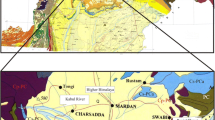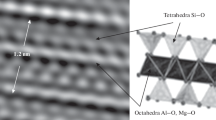Abstract
Two bentonite deposits having average thicknesses of 10 and 4 ft are exposed within nonmarine strata of Late Cretaccous age along the Battle River near Rosalind, Alberta. They are characterized by scarcity of >44 µm material and variable 44-2 µm and <2 µm contents. Material >44 µm in size in excess of 2 per cent is primarily attributable to secondary calcite, and <2 µm content may be related to the amount of 44-2 µm material that has altered diagenetically from volcanic glass to montmorillonite. Rhyodacite was the probable composition of the parent ash; therefore, the high iron content in one deposit is probably due to diagenesis. The blocking effect of iron on exchange sites can explain differences in exchangeable Na and Ca in different deposits. High exchangeable Na found in finer subdivisions of fractionated clay can be explained by increased purity of the bentonite.
Multiple regression analysis of the analytical data shows that 48 per cent of the variation in yield (bbl/T.) of 15 centipoise drilling mud can be attributed to concomitant variation in seven interrelated compositional properties. Sequential analysis shows that <0·2 µm clay content is the most important contributor to variation in yield. The remaining variables (total clay content, exchangeable Na, exchangeable Ca + Mg, Fe2+ and Fe3+ contents, and CEC) contribute little additional precision to the regression analysis when <0·2 µm clay content is included in the equation.
Résumé
Deux dépôts de bentonite d’une épaisseur moyenne de 10 et 4 pieds sont visibles à l’intérieur de stratifications non marines du crétacé supérieur, le long de la Battle River près de Rosalind, Alberta. Ils sont caractérisés par la rareté du matériel >44 µm et des teneurs variables en matériels 44–2 µm et <2 µm. Le matériel >44µm présent à une concentration supérieure à 2 pour cent est principalement attribuable à une calcite secondaire et la teneur en matériel <2 µm peut être reliée à la quantité de matériel 44–2 µm qui a été altéré en montmorillonite par diagenèse à partir d’un verre volcanique. La cendre initiale avait probablement la composition d’une rhyodacite; de la sorte, la teneur élevée en fer dans l’un des dépôts est probablement due à la diagénèse. L’effet de blocage des sites d’échange par le fer peut expliquer les différences en Na et Ca échangeables dans les différents dépôts. La teneur élevée en Na échangeable trouvée dans les fractions granulométriques les plus fines de l’argile, peut être expliquée par une pureté accrue de la bentonite.
L’analyse de régression multiple des résultats analytiques montre que 48 pour cent de la variation du rendement (bbl/T.) en boue de forage à 15 centipoises, peuvent être attribués à la variation concomittante de sept facteurs intercorrélés affectant la composition. L’analyse séquentielle montre que la teneur en argile <0,2 µm contribue le plus fortement à la variation du rendement. Les autres variables (teneur totale en argile, Na échangeable, Ca + Mg échangeables, teneurs en Fe2+ et Fe3+ et CEC) contribuent légèrement à améliorer la précision de l’analyse de régression quand la teneur en argile <0,2 µm est incluse dans l’équation.
Kurzreferat
Zwei Bentonitlagerstätten mit einer durchschnittlichen Mächtigkeit von 3 und 1,2 m sind entlang dem Battle-Fluß in der Nähe von Rosalind, Alberta, innerhalb nichtmariner Schichten der Oberkreide aufgeschlossen. Sie sind durch Armut an Material >44 µm und wechselnde Gehalte an den Fraktionen 44–2 µm und <2 µm gekennzeichnet. Das Material >44 µm ist, soweit die Gehalte 2 Prozent übersteigen, in erster Linie auf sekundären Calcit zurückzuführen. Die Fraktion <2 µm steht mit der Menge der Fraktion 44–2 µm, die diagnetisch aus vulkanischem Glas zu Montmorillonit umgewandelt wurde, in Beziehung. Die mutmaßliche Zusammensetzung der ursprünglichen Asche bestand aus Rhyodacit. Der hohe Eisengehalt in einer Lagerstätte ist daher wahrscheinlich durch Diagenese bedingt. Die blockierende Wirkung des Eisens auf die Austauschplätze vermag die Unterschiede im austauschbaren Na und Ca in den verschiedenen Lagerstätten zu erklären. Die in feineren Korngrößenunterteilungen des fraktionierten Tones ermittelten hohen Gehalte an austauschbarem Natrium können durch zunehmende Reinheit des Bentonits erklärt werden.
Die multiple Regressionsanalyse der analytischen Daten zeigt, daß 48 Prozent der Varianz des Ertrages (bbl/T) einer Bohrflüssigkeit von 15 Centipoise der gleichzeitigen Varianz von sieben in Wechselbeziehung stehenden, die Zusammensetzung betreffenden Eigenschaften zugeschrieben werden kann. Die Sequenz-analyse zeigt, daß der Gehalt von Ton <0,2 µm die wichtigste Bestimmungsgröße der Ertragsvarianz darstellt. Die verbleibenden Variablen (Gesamttongehalt, austauschbares Na, austauschbares Ca + Mg, Fe2+- und Fe3+-Gehalt und Austauschkapazität) tragen wenig zur zusätzlichen Genauigkeit der Regressionsanalyse bei, wenn der Gehalt an Ton <0,2 µm in die Gleichung einbezogen wird.
Резюме
В Альберте по реке Баттл около Розалинда имеется два обнаженных месторождения бентонита, неморского отложения позднего мелового периода, средней толщиной 10 и 4 фута. Они характеризуются недостатком вещества 44-2 µM и < 2 µM. Более двух процентов вещества размером >44 µM прежде всего приписывается кальциту наносного происхождения, а содержание <2 µM может быть отнесено к веществу 44-2 µM, которое диагенетически изменялось из вулканического стекла в монтмориллонит. Составом материнского пепла, вероятно, был риодацит; высокое содержание железа в одном из залежей по всей вероятности является результатом диагенеза. Эффект торможения производимый железом на местоположения обмена, объясняет разницу в обменных Na и Са в различных отложениях. Высокообменный Nd, найденный во фракциях глины можно приписать чистоте бентонита.
Рассмотрение данных множественной регресси показало, что сорок восемь процентов в выходе (ЬЫ/Т) можно отнести к сопровождающему изменению связанных между собой свойств смеси. Последующий анализ выявил, что <0,2 µM содержания глины является самым важным вкладчиком в изменение выхода. Остальные переменные (общее содержание глины, обменный Nа, содержание обменных Са + Мg, Fe+2 и Fe+3, и С.Е.С.) не вносят добавочную точность к анализу регрессии, если <0,2 µM содержания глины включается в уравнение.
Similar content being viewed by others
References
Allan, J. A. and Sanderson, J. O. G. (1945) Geology of Red Deer and Rosebud sheets, Alberta: Res. Coun. Alberta Rept. 13.
American Petroleum Institute (1969a) API specifications for oil-well drilling-fluid materials: API Std 13A, Am. Petrol. Inst., Div. Production, Dallas.
American Petroleum Institute (1969b) Standard procedure for testing drilling fluids: API RP 13B, Am. Petrol. Inst., Div. Production, Dallas.
Berg, R. B. (1969) Bentonite in Montana: Mont. Bur. Mines and Geol. Bull. 74.
Davidtz, J. C. and Low, P. F. (1970) Relation between crystal-lattice configuration and swelling of montmoril-lonites: Clays and Clay Minerals 18, 325–332.
Foster, M. D. (1953) Geochemical studies of clay minerals— II. Relations between ionic substitution and swelling in montmorillonite: Am. Mineralogist 38, 994–1006.
Foster, M. D. (1955) The relation between composition and swelling in clays: Clays and Clay Minerals 3, 205–220. [Natl Acad. Sci.—Natl Res. Council Pub. 395]
Gillery, F. H. (1959) Adsorption–desorption characteristics of synthetic montmorillonoids in humid atmospheres: Am. Mineralogist 44, 806–818.
Goodyear, J. and Duffin, W. J. (1954) The identification and determination of plagioclase feldspars by the X-ray powder method: Mm. Mag. 30, 306–326.
Güven, N. and Grim, R. E. (1972) X-ray diffraction and electron optical studies on smectite and α-cristobalite associations: Clays and Clay Minerals 20, 89–92.
Henderson, J. H., Jackson, M. L., Syers, J. K., Clayton, R. N. and Rex, R. W. (1971) Cristobalite authigenic origin in relation to montmorillonite and quartz origin in bentonites: Clays and Clay Minerals 19, 229–238.
Irish, E. J. W. (1970) The Edmonton Group of south-central Alberta: Bull. Can. Petrol. Geol. 18, 125–155.
Jackson, M. L., Whittig, L. D. and Pennington, R. P. (1950) Segregation procedure for the mineralogical analysis of soils: Soil Sci. Soc. Am. Proc. 14, 77–81.
Knechtel, W. M. and Patterson, S. H. (1956) Bentonite deposits in marine Cretaceous formations, Hardin district, Montana and Wyoming: U.S. Geol. Surv. Bull. 1023.
Knechtel, W. M. and Patterson, S. H. (1962) Bentonite deposits of the northern Black Hills district, Wyoming, Montana, and South Dakota: U.S. Geol. Surv. Bull. 1082-M, 893–1030.
Lerbekmo, J. F. (1968) Chemical and modal analyses of some Upper Cretaceous and Paleocene bentonites from western Alberta: Can. J. Earth Sci. 5, 1505–1511.
McAtee, J. L., Jr. (1958) Heterogeneity in montmorillonite: Clays and Clay Minerals 5, 279–288. [Natl Acad. Sci — Natl Res. Council Pub 566].
Mungan, N. and Jessen, F. W. (1963) Studies in fractionated montmorillonite suspensions: Cfays and Clay Minerals 11, 283–294. [Pergamon Press, New York].
Ravina, I. and Low, P. F. (1972) Relation between swelling water properties and fe-dimension in montmorillonite-water systems: Clays and Clay Minerals 20, 109–123.
Rock-Color Chart Committee (1963) Rock-Color Chart: Geol. Soc. Am., New York.
Ross, J. S. (1964) Bentonite in Canada: Dept. Mines and Tech. Surv., Mines Br. Mono. 873, Ottawa.
Slaughter, M. and Earley, J. W. (1965) Mineralogy and geological significance of the Mowry bentonites, Wyoming: Geol. Soc. Am. Spec. Paper 83.
Snedecor, G. W. (1956) Statistical methods: Iowa State College Press, Ames.
Tanner, C. B. and Jackson, M. L. (1948) Nomographs of sedimentation times for soil particles under gravity or centrifugal acceleration: Soil Sci. Soc. Am. Proc. 12, 60–65.
Williams, F. J., Neznayko, M. and Weintritt, D. J. (1953a) The effect of exchangeable bases on the colloidal properties of bentonite: J. Phys. Chem. 57, 6–10.
Williams, F. J., Elsley, B. C. and Weintritt, D. J. (1953b) The variations of Wyoming bentonite beds as a function of the overburden: Clays and Clay Minerals 7, 141–151. [Pergamon Press, New York].
Author information
Authors and Affiliations
Rights and permissions
About this article
Cite this article
Scafe, D.W. Bentonite Characteristics from Deposits near Rosalind, Alberta. Clays Clay Miner. 21, 437–449 (1973). https://doi.org/10.1346/CCMN.1973.0210603
Received:
Published:
Issue Date:
DOI: https://doi.org/10.1346/CCMN.1973.0210603




